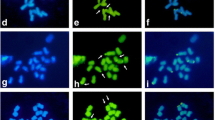Abstract
Fluorescent in situ hybridization (FISH) was used to reveal the intrachromosomal organization of 11 RAPD markers localized on the genetic map of Petunia hybrida. The cloned RAPD markers were analyzed by means of Southern hybridization to determine their level of sequence repetition and their specificity in different Petunia species with 2n=14 and 18 chromosomes. The same probes were then used in FISH experiments. Most of the RAPD clones studied showed high sequence repetition and no species specificity. Moreover, FISH analysis showed that these probes could belong to multilocus families as evidenced by the multiple FISH signals dispersed throughout the genome and present on every chromosome. Only 3 RAPD clones revealed species specificity at the chromosome level. Clones OPJ18-250 and V20-350 were only detected by FISH in the white-flowered species and clone OPV08-600 only in species with colored flowers. They were localized at one two or three pairs of fluorescent sites. The localization of OPJ18-250 at a unique site on chromosome VI give us the opportunity to compare genetic and physical distances.
Similar content being viewed by others
Author information
Authors and Affiliations
Additional information
Received: 19 June 1998 / Accepted: 15 July 1998
Rights and permissions
About this article
Cite this article
Benabdelmouna, A., Peltier, D., Humbert, C. et al. Southern and fluorescent in situ hybridization detect three RAPD-generated PCR products useful as introgression markers in Petunia. Theor Appl Genet 98, 10–17 (1999). https://doi.org/10.1007/s001220051034
Issue Date:
DOI: https://doi.org/10.1007/s001220051034




